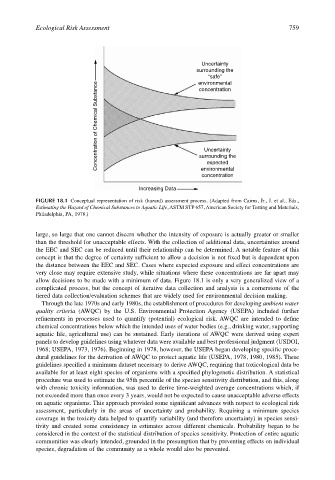Page 779 - The Toxicology of Fishes
P. 779
Ecological Risk Assessment 759
Uncertainty
surrounding the
“safe”
environmental
Concentration of Chemical Substance Uncertainty
concentration
surrounding the
expected
environmental
concentration
Increasing Data
FIGURE 18.1 Conceptual representation of risk (hazard) assessment process. (Adapted from Cairns, Jr., J. et al., Eds.,
Estimating the Hazard of Chemical Substances to Aquatic Life, ASTM STP 657, American Society for Testing and Materials,
Philadelphia, PA, 1978.)
large, so large that one cannot discern whether the intensity of exposure is actually greater or smaller
than the threshold for unacceptable effects. With the collection of additional data, uncertainties around
the EEC and SEC can be reduced until their relationship can be determined. A notable feature of this
concept is that the degree of certainty sufficient to allow a decision is not fixed but is dependent upon
the distance between the EEC and SEC. Cases where expected exposure and effect concentrations are
very close may require extensive study, while situations where these concentrations are far apart may
allow decisions to be made with a minimum of data. Figure 18.1 is only a very generalized view of a
complicated process, but the concept of iterative data collection and analysis is a cornerstone of the
tiered data collection/evaluation schemes that are widely used for environmental decision making.
Through the late 1970s and early 1980s, the establishment of procedures for developing ambient water
quality criteria (AWQC) by the U.S. Environmental Protection Agency (USEPA) included further
refinements in processes used to quantify (potential) ecological risk. AWQC are intended to define
chemical concentrations below which the intended uses of water bodies (e.g., drinking water, supporting
aquatic life, agricultural use) can be sustained. Early iterations of AWQC were derived using expert
panels to develop guidelines using whatever data were available and best professional judgment (USDOI,
1968; USEPA, 1973, 1976). Beginning in 1978, however, the USEPA began developing specific proce-
dural guidelines for the derivation of AWQC to protect aquatic life (USEPA, 1978, 1980, 1985). These
guidelines specified a minimum dataset necessary to derive AWQC, requiring that toxicological data be
available for at least eight species of organisms with a specified phylogenetic distribution. A statistical
procedure was used to estimate the 95th percentile of the species sensitivity distribution, and this, along
with chronic toxicity information, was used to derive time-weighted average concentrations which, if
not exceeded more than once every 3 years, would not be expected to cause unacceptable adverse effects
on aquatic organisms. This approach provided some significant advances with respect to ecological risk
assessment, particularly in the areas of uncertainty and probability. Requiring a minimum species
coverage in the toxicity data helped to quantify variability (and therefore uncertainty) in species sensi-
tivity and created some consistency in estimates across different chemicals. Probability began to be
considered in the context of the statistical distribution of species sensitivity. Protection of entire aquatic
communities was clearly intended, grounded in the presumption that by preventing effects on individual
species, degradation of the community as a whole would also be prevented.

